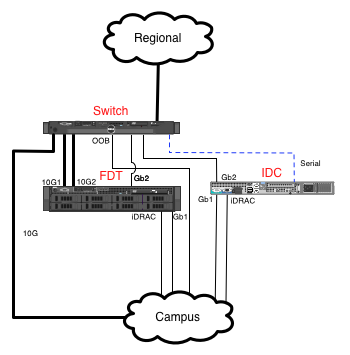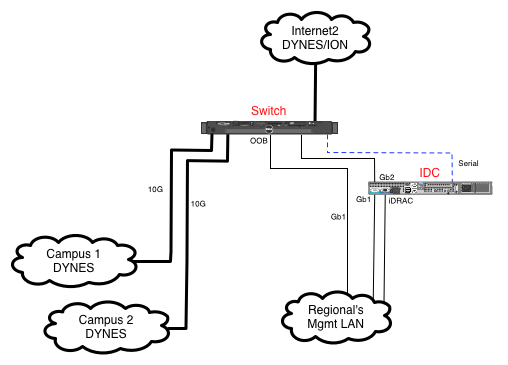DYNES Documentation
We encourage you to join the community list, dynes-deployments@internet2.edu. Some of you should be on this, if not subscribe here: https://lists.internet2.edu/sympa/subscribe/dynes-deployments. We are still going to be available to answer questions regarding operations, but it’s important that you try things first (don't be afraid to fail) before pulling the panic switch. Some things to note: - We maintain accounts to make sure things are running, but we want all sites to begin the process to monitor and ensure these devices are integrated into the environment. This means use RANCID on the switch, use NAGIOS on the servers, get comfortable with managing the OS and software (it's just linux under the hood). The OSCARS software is not unique to DYNES and as such we do not develop it or support it directly within this project. We are encouraging people to join the OSCARS user community (oscars-users@es.net, join here:https://listserv.es.net/mailman/listinfo/oscars-users) for support from the developers and users of the software directly.
Please note the following from the DYNES FAQ
DYNES is NSF funded to deliver hardware to campuses to enable dynamic circuit capabilities. As such, the group of DYNES PIs do not control/maintain the equipment directly beyond our initial installation efforts. All sites are under local control after commissioning, with some caveats:
- The PIs/staff maintain a 'DYNES' account for access to ensure that the distributed instrument is running.
- The PIs/staff also have rudimentary NAGIOS/Syslog/Rancid monitoring running to ensure the overall health of the system.
- Each of the sites have root access to the machines and switches (SSH not enabled by default) as well as a local 'admin' account (SSH enabled) to perform management activities.
With regards to the first two items, the PIs want to re-emphasize that the equipment is under local control and management. Since this has been integrated into campus environments, its up to the end site to set local policy regarding access as well as maintain local monitoring. This will help come August 2013 when the DYNES project funding ends, and the destiny of this as a Layer 2 solution becomes a community effort. If you have not done so, please consider using enterprise monitoring techniques for the equipment.
DYNES Overview
NSF-funded project (grant number 0958998) has developed and deployed the Dynamic Network System (DYNES), a nationwide cyber-instrument spanning about 40 US universities and 14 Internet2 connectors. A collaborative team including Internet2, Caltech, University of Michigan, and Vanderbilt University worked with regional networks and campuses to support large, long-distance scientific data flows in the LHC, other leading programs in data intensive science (such as LIGO, Virtual Observatory, and other large scale sky surveys), and the broader scientific community.
The DYNES instrument consists of several pieces of equipment. At campus sites the instrument comprises a server that acts as an IDC (InterDomain Controller), an FDT (Fast Data Transfer) disk array server, and a switch. At regional sites the instrument consists of just the IDC and switch. The pictures below show a generic campus configuration. Specific site configurations will vary.
This picture shows a generic regional configuration. The Regional cloud in the above campus picture is essentially represented below. Each Campus DYNES cloud below corresponds to the above picture.
Internet2's ION connects the regional DYNES instruments with each other and with other non-DYNES ION reachable entities. Referring to the above picture, Campus 1 can create a connections to Campus 2 through the Regional without going through Internet2. If Campus 1 wants to create a connection to another campus served by a different regional or to a non-DYNES (but ION reachable) site then that connection goes through Internet2's ION.
In some cases, a campus may connect directly with Internet2's ION and either not pass through a regional or the regional will provision static VLANs in its infrastructure to allow the set of VLANs designated to the campus for DYNES to pass through.
DYNES URL
The DYNES website is found here.
DYNES FAQ
The DYNES FAQ is being maintained by NOC and Internet2 staff and can be found at:
DYNES Contact Information
For problems with the DYNES System installation, configuration and access, please send email to dynes-turnup-support@grnoc.iu.edu.
We welcome your comments and feedback on this documentation. Please send along any comments or critiques to the dynes-deployments mail list so we can improve it.
Structure of the DYNES Documentation
There is a user section and an administrator section.

